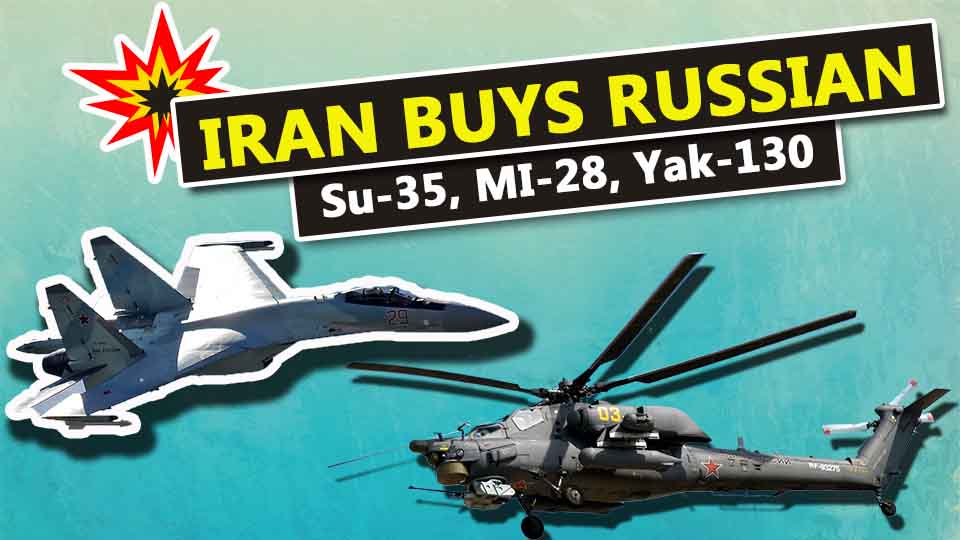Aerospace
Iran Finalizes Contract to Procure Russian Fighter Aircraft

Iran has concluded its plans to procure military aircraft from Russia, as reported by Iranian state media.
The finalized agreement includes the purchase of advanced Russian military assets, including Yak-130 jet trainers, Mil Mi-28 attack helicopters, and Sukhoi Su-35 fighter jets, as confirmed by Brigadier General Mahdi Farahi, Iran’s Deputy Defence Minister.
Iran has the most military helicopters in the area and has significantly improved its capabilities through a number of upgrade projects. Tehran is expected to receive 24 Su-35 Flanker-E fighter jets from Moscow, although the deputy minister did not specify how many aircraft were scheduled for delivery.
Iranian is facing geopolitical issues with the US Earlier. it used to have f-16 and other fighter jets which were built by the US operating in the Iran Air Force. Later on with the Middle East political tension united States rejected arms supplies to Iran. Further, Iran depended on russia and the Turkish aircraft. Due to recent Israel conflicts it planning to procure more defensive products from Russia.
Su-35s would be a major upgrade over Iran’s current fleet of aircraft, but how much better the planes are will depend on a number of factors, such as the equipment, training, and other capabilities that come with them and how well they integrate with Iran’s potent integrated air and missile defense systems.
Whatever the case, the growing security cooperation between Russia and Iran poses a serious challenge to American allies in Europe, Israel, and the Arab world. Washington and its allies and partners should work together to counter the expanding Russian-Iranian axis rather than worrying about the issue separately.
Addressing last week, John Kirby, a spokesman for the US National Security Council, said that after giving Moscow drones, guided aerial bombs, and artillery ammunition, Tehran might now supply Russia with ballistic missiles to use in its conflict in Ukraine. In return, Iran is seeking billions of dollars worth of military hardware from Russia in exchange for bolstering its military capabilities.

Aerospace
Boeing Transfers Rocket Stage to NASA, Paving Way for Human Moon Mission

Boeing has achieved a significant milestone by providing NASA with the second core stage of the Space Launch System (SLS) rocket.
This crucial component, crafted at NASA’s Michoud Assembly Facility (MAF), is set to propel the Artemis II crew into lunar orbit, marking humanity’s return to deep space after a 50-year hiatus.
The monumental Boeing-built rocket stage, the largest element of the Artemis II mission, will embark on a journey aboard the Pegasus barge, traveling 900 miles to NASA’s Kennedy Space Center.
Comparison of two legendary aircraft B777x vs B747 aircraft:Click here
Upon arrival, it will be meticulously integrated with other essential Artemis II components, including the upper stage, solid rocket boosters, and NASA’s Orion spacecraft within the iconic Vehicle Assembly Building. This intricate integration process is a vital step toward the eagerly anticipated Artemis II launch, slated for 2025.
“Boeing-built products helped land humankind on the moon in 1969, and we’re proud to continue that legacy through the Artemis generation,” remarked Dave Dutcher, vice president and program manager for Boeing’s SLS program. “Together, with NASA and our industry partners and suppliers, we are building the world’s most capable rocket and paving the way to deep space through America’s rocket factory in New Orleans.”
NASA, Lockheed Martin Reveal X-59 Quiet Supersonic Aircraft:Click here
The delivery of Core Stage 2 marks a significant achievement in the evolution of the SLS rocket. Towering over 200 feet and powered by four RS-25 engines, this core stage, coupled with two solid-fueled booster rockets, will generate a staggering 8.8 million pounds of thrust. This immense power is crucial to launching Artemis II and future missions into the vast expanse of space.
The SLS rocket stands unparalleled in its capability to transport both crew and substantial cargo to the moon and beyond in a single launch. Its extraordinary capacity will facilitate the delivery of human-rated spacecraft, habitats, and scientific missions to destinations including the moon and Mars, ushering in a new era of space exploration.
-

 Travel1 week ago
Travel1 week agoAir India to Expand US Operations with Three New Routes After a Decade
-

 Travel2 weeks ago
Travel2 weeks agoWhy We Should Avoid These Stamps in a Passport
-

 Airlines1 month ago
Airlines1 month agoInvestigations Reveal Fake Chinese Titanium in Boeing and Airbus Jets
-

 Tech4 weeks ago
Tech4 weeks agoChina’s CATL Plans 1,800-Mile Electric Plane Launch by 2027
-

 Airport3 days ago
Airport3 days agoTop 10 Largest Airports in the World by Size
-

 Aerospace4 weeks ago
Aerospace4 weeks agoChina’s Fighter Jets Turn Wings into Autonomous Drones
-

 Airlines4 days ago
Airlines4 days agoAir India Rolls Out A350s for Delhi-New York JFK and Newark Routes
-

 Defence3 weeks ago
Defence3 weeks agoBoeing Enhances Chinook with New Engines and Block II Upgrades at $96 Million







